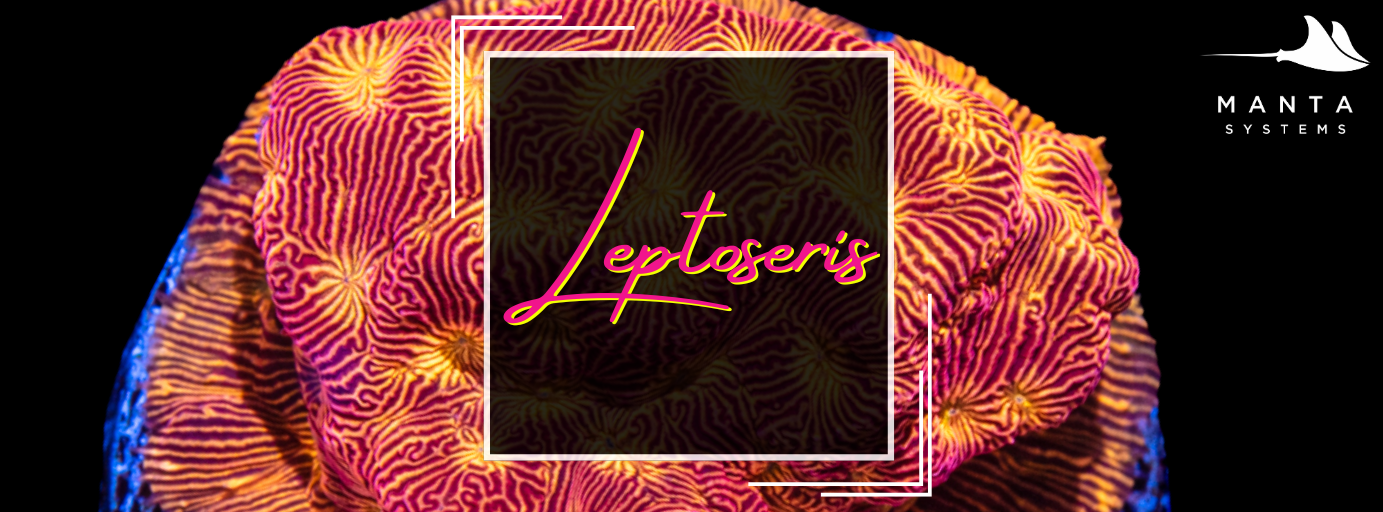
Banner Image Credit: Tidal Gardens
𝐖𝐡𝐲 𝐋𝐞𝐩𝐭𝐨𝐬𝐞𝐫𝐢𝐬 𝐃𝐞𝐬𝐞𝐫𝐯𝐞𝐬 𝐚 𝐒𝐩𝐨𝐭𝐥𝐢𝐠𝐡𝐭
Introduction
Let me tell you, Leptoseris is hands-down one of the coolest corals you can add to your reef tank. It’s like that quiet guest at the party who, once the lights dim, steals the show with an unexpected neon glow. If you’re looking to add some serious visual magic to your reef, especially in those shadowy, hard-to-fill spots, Leptoseris delivers in spades. These guys are underrated, easy to care for, and absolutely pop under blues.
What is Leptoseris?
Type:
Technically a Small Polyp Stony (SPS) coral, but don’t let that label intimidate you. While it’s classified alongside the fussier SPS like Acropora, Leptoseris behaves way more like a chill LPS in terms of care needs. It’s a dream for hobbyists who want a splash of SPS beauty without the high-maintenance drama.
Family:
Agariciidae — this family includes a variety of encrusting and plating corals, many of which are known for their unique skeletal structures and light-gathering abilities.
Natural Habitat:
Leptoseris naturally grows in the deeper, shaded parts of Indo-Pacific reefs, particularly along reef slopes, caves, and under overhangs. In the wild, they thrive in lower light conditions compared to their shallow-water cousins. This natural environment has shaped them into exceptional “light catchers” — they’ve evolved to maximize the limited sunlight they receive.
Growth Form and Texture:
Leptoseris is famous for its ultra-thin, delicate plating growth. Picture thin, often overlapping plates that spread like rings of tree bark across rock surfaces. Some varieties even develop subtle ruffles or ridges as they grow, giving them a gorgeous, natural texture.
The surface of a healthy Leptoseris is covered in fine, bright-colored polyps that almost look like shimmering velvet under the right lighting. Don’t expect big, waving tentacles — this coral is all about that understated, encrusting elegance.
Colors and Fluorescence:
This is where Leptoseris really steals the show. In blue LED lighting, they glow with electric greens, oranges, fiery reds, and even neon yellows. Many varieties exhibit intense fluorescence under actinic lighting, making them one of the most eye-catching corals for nighttime viewing.
Common color morphs include:
•Neon green (super common and always stunning)
•Bright orange or rust red
•Teal or bluish hues
•Highlighter yellow (rarer but breathtaking)
Tamara’s Pro Tip: If you’re a sucker for that jaw-dropping glow when your moonlights kick on, Leptoseris is a must. Place it where you’ll see it at night — trust me, you’ll want to show this one off during evening tank-gazing sessions!
Popular Species in the Hobby
Leptoseris corals come in a rainbow of colors and subtle textures that make them irresistible for reef keepers. Here are a few standout species you’re likely to encounter — though, to be fair, many frags are sold by color rather than scientific name (and that’s totally okay).
1. Leptoseris mycetoseroides
Golden to orange “sunset” tones that absolutely glow under actinic or blue lighting. This variety is famous for its radiant warmth, giving your reef a splash of sunset right on your rockwork. Especially striking in lower sections of your tank where the shimmer effect really pops.
2. Leptoseris hawaiiensis
This is that electric green one that looks almost too good to be true. Under blue LEDs, it practically lights up like a neon sign at a beach bar. It’s fast-growing and super eye-catching — great for adding instant energy to your aquascape.
3. Leptoseris yabei
Known for its mesmerizing wavy texture and intricate patterns, this species is a conversation starter. It often mixes oranges, golds, and subtle highlights, making it a centerpiece for encrusting coral lovers. The texture catches shadows and light beautifully, especially in lower flow areas.
Tamara’s Pro Tip: Don’t stress too much about getting the species name perfect. Many vendors sell Leptoseris by “color morph” rather than strict species. Focus on what catches your eye — healthy tissue, great color, and growth form matter far more than the label.
Tank Placement
- Perfect for lower rockwork, shadowy overhangs, or those areas of your aquascape that feel a little underwhelming. Leptoseris shines in spots where other corals might sulk.
- Surprisingly adaptable to vertical surfaces and even cave ceilings — yep, you read that right! Their encrusting nature makes them excellent for adding depth and interest to your scape in places you might otherwise overlook.
- Avoid placing them in high-exposure zones. Too much direct light or aggressive flow can cause tissue stress, leading to fading color or even recession.
Tamara’s Pro Tip: If you’re running a mixed reef and have SPS hogging the prime real estate up top, Leptoseris gives you color and texture down low where others might not thrive.
Lighting Requirements
- Moderate to low light is absolutely their sweet spot. These corals aren’t fans of sunbathing all day long under blazing LEDs.
- Target PAR levels in the range of 50 to 150. Think of them as the twilight-zone dwellers of your reef — they appreciate that gentle glow.
- Too much light will actually wash out their vibrant colors. You might notice them fading or, worse, starting to bleach if they’re overexposed.
- On the flip side, too little light isn’t ideal either. Growth will slow to a crawl, and their stunning fluorescence will start to dull.
Tamara’s Pro Tip: If your tank is on the cleaner side with lower nutrients, slightly lower light often keeps the colors richer and more saturated. Don’t be afraid to experiment!
Flow Preferences
- Moderate, indirect flow is where these corals thrive. Think of it like a calm breeze on a tropical day — not too strong, not too still.
- Gentle current helps keep detritus from settling on the coral’s surface, which is especially important since their thin tissue can trap debris easily.
- Too much flow is a recipe for trouble. The tissue on Leptoseris is delicate and thin, and strong, direct flow can cause tears or stress that sets back their growth.
- On the flip side, too little flow lets detritus and gunk settle in, which can lead to tissue recession or even algae settling on the coral. No one wants that.
Feeding and Nutrition
- Fully photosynthetic, so they get most of their energy from light. This makes them low maintenance in the feeding department, especially in well-lit reef tanks.
- That said, a little snack never hurts! Leptoseris responds surprisingly well to broadcast feeding, especially with fine powdered or liquid coral foods designed for filter-feeding corals.
- Occasional treats like microplankton, phytoplankton, or even finely blended meaty foods can encourage better growth rates and richer coloration. This is especially helpful in ultra-clean, nutrient-poor tanks where they might not get enough organic matter from the water column.
- Feeding once or twice a week is plenty. Overfeeding can lead to excess nutrients in the tank, so it’s best to go light and observe how your coral responds.
Tamara’s Pro Tip: I’ve seen noticeable color improvement with light weekly feeding, especially in nutrient-poor tanks.
Growth Speed
Leptoseris grows at a moderate pace. Faster than many SPS corals, especially under stable tank conditions, but not so aggressive that it takes over. Once settled, you’ll notice it spreading across rock surfaces, sometimes even encrusting around neighboring corals (so give it some elbow room).
Tamara’s Pro Tip: While it’s not a rapid invader, don’t let it sneak up on your prized zoas or acans. Give Leptoseris its own stage to shine!
Water Parameters for Success
-
Temperature: 75 to 78°F
-
Salinity: 1.025 to 1.026
-
pH: 8.1 to 8.4
-
Alkalinity: 8 to 10 dKH
-
Calcium: 400 to 450 ppm
-
Magnesium: 1250 to 1350 ppm
-
Nitrate: 5 to 10 ppm
-
Phosphate: 0.03 to 0.08 ppm
Tamara’s Pro Tip: Stable parameters matter more than chasing perfection. Leptoseris will reward you with glow for your consistency!
Troubleshooting
1. Problem: Tissue Recession
Cause: Usually the result of too much light too fast (light shock), unstable water parameters like fluctuating alkalinity, or sneaky pests like nudibranchs and flatworms nibbling away at tissue.
Solution:
- First, test and stabilize your core water parameters: alkalinity, calcium, magnesium, and nutrients.
- Reassess your lighting intensity and duration. If you recently upgraded or repositioned your lighting, reduce intensity or move the coral lower in the tank.
- Give the coral a close inspection—flatworms and nudis are masters of disguise. A quick coral-safe dip can help eliminate pests.
Tamara’s Pro Tip: Leptoseris is thinner-tissued than many LPS or other encrusting corals, so it shows stress early. Catching tissue recession fast can save the whole colony!
2. Problem: Faded Colors
Cause: Insufficient lighting or very low nutrient levels. In ultra-clean tanks, corals sometimes starve for just a little organic “fuel.”
Solution:
- Increase lighting slowly if your PAR is below 50.
- Start light supplemental feedings once or twice a week with broadcast coral foods.
- Check your nitrate and phosphate levels. Aim for around 2–10 ppm nitrate and 0.03–0.1 ppm phosphate for balanced coloration.
Tamara’s Pro Tip: I’ve noticed Leptoseris glows best when it’s a little spoiled. If you’re running nutrient export aggressively, they’ll appreciate a little target feeding.
3. Problem: Detritus Buildup
Cause: Insufficient flow or placing the coral in dead zones where detritus settles.
Solution:
- Adjust powerheads or flow nozzles to create a gentle, indirect current over the Leptoseris.
- Avoid direct blast flow, but make sure there’s enough movement to keep debris suspended in the water column for your filtration to handle.
- During routine maintenance, gently baste or siphon off any buildup around the coral’s base.
Tamara’s Pro Tip: I like to give Leptoseris a light “turkey baster rinse” every couple of weeks to keep it looking fresh and prevent gunk buildup in its folds.
Aggression
- No sweeper tentacles to worry about, so Leptoseris won’t go picking fights with its neighbors. It minds its own business and just focuses on growing beautifully.
- However, avoid crowding it with aggressive or fast-spreading corals like Green Star Polyps (GSP), Xenia, or fast-growing mushrooms. These can easily overrun the slower-growing Leptoseris and shade it out or physically smother it.
- Give it breathing room! While Leptoseris doesn’t attack, it still appreciates a few inches of space to grow freely without competition.
FAQs About Leptoseris
1. Can Leptoseris thrive in nano tanks?
-
Yes! Their light and flow needs make them nano-friendly.
2. Does Leptoseris sting other corals?
-
Not at all. It’s peaceful but don’t let it get overgrown by neighbors.
3. How fast does Leptoseris grow?
-
Moderate speed. Faster than some SPS, slower than softies.
4. Does it glow under blue light?
-
Oh, absolutely. One of the best glow-ups in the hobby.
Conclusion
Leptoseris is the unsung hero of the reef hobby. It fills in shady gaps, dazzles under blue light, and brings quiet beauty to any aquascape. Easygoing and adaptable, this coral deserves a place in more tanks. If you’re looking to diversify your reef with something that stands out without demanding constant attention, Leptoseris is a winner.
Happy Reefing!
References:
-
Borneman, Eric H. Aquarium Corals: Selection, Husbandry, and Natural History. TFH Publications, 2001.
-
Calfo, Anthony, and Robert Fenner. Reef Invertebrates: An Essential Guide to Selection, Care, and Compatibility. Reading Trees Publications, 2003.
-
Delbeek, J. Charles, and Julian Sprung. The Reef Aquarium: A Comprehensive Guide to the Identification and Care of Tropical Marine Invertebrates. Vol. 1, Ricordea Publishing, 1994.
-
Fenner, Robert M. The Conscientious Marine Aquarist: A Commonsense Handbook for Successful Saltwater Hobbyists. TFH Publications, 2008.
